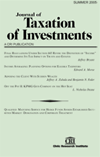Real Estate as a Capital Asset or Inventory: The Judicial Debate Revisited
Author: James A. Fellows.; Michael A. Yuhas.; John F. Jewell.
Source: Volume 27, Number 02, Winter 2010 , pp.56-74(19)

< previous article |next article > |return to table of contents
Abstract:
One of the more popular “urban tax legends” is that all real estate is, ipso facto, classified as a capital asset under federal tax law. Whether real estate is deemed a capital asset or not is determined by all the facts and circumstances of each individual case. The benefit of capital asset classification, should that be the result, is that gains from the sale of the realty are given preferential tax treatment, if the property is held for more than one year, thus giving it status as a long-term capital asset. Currently the maximum tax rate on net long-term capital gains is 15 percent, whereas the rate on other income can be as high as 35 percent. The 35 percent maximum rate also applies to net short-term capital gains on sales of capital assets held one year or less. Since 1921, long-term capital gains have generally received some form of preferential tax treatment relative to other income. It seems a safe prediction that future tax laws will maintain some form of these favorable tax rate differentials. Real estate investors, however, cannot simply designate their property as a capital asset, anticipating favorable tax treatment if they hold the property more than one year. In many instances, the property must be classified as inventory, if the facts indicate that the owner of the property is in reality a dealer in the real estate. The issue of dealer versus investor status has been litigated extensively in the courts, and a recent decision by the U.S. Tax Court, Rice v. Commissioner, once again brings the debate front and center. This article reviews the important judicial history on the dealer versus investor classification before discussing the Tax Court decision in Rice and includes in the discussion a critique of the Rice decision, using as a framework the judicial precedent on the issue.Keywords:
Affiliations:
1: University of South Florida-St. Petersburg; 2: Grand Valley State University; 3: University of South Florida-St. Petersburg.